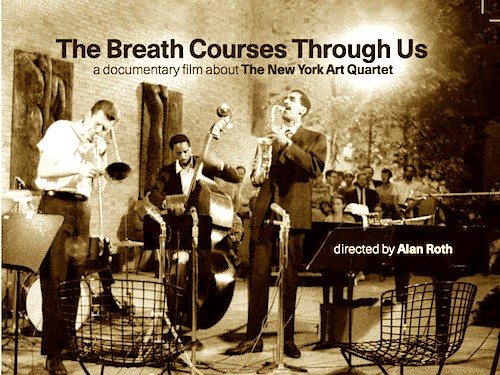Trailer – The Breath Courses Through Us (2013) from Asymmetric Pictures –FILMS on Vimeo.
By Joe Bendel. They were arguably the original super group of free jazz. They formed in 1964 and disbanded in 1965, yet they still had turnover on the bass. Eventually, Reggie Workman settled into the role and would return for their special anniversary tour. Despite the brevity of their tenure together, the New York Art Quartet remains enormously influential. Alan Roth documents their history and triumphant reunion in The Breath Courses Through Us, which has its American premiere today at the Library of Congress in Washington, DC.
It all started when Congolese-Danish alto-saxophonist John Tchicai met trombonist Roswell Rudd. Both musicians were exploring the creatively disruptive innovations of Cecil Taylor, recognizing each other as kindred spirits. The next piece of the puzzle was Milford Graves, a former Latin percussion specialist, who had reoriented his perspective on the drums after hearing Elvin Jones. As the New York Art Quartet, they recorded their instantly recognizable eponymous ESP release with Bernie Worrell on bass, bringing Workman on board for Mohawk the following year.
As is usually the case in jazz, the Quartet was short lived, precisely because it was just five minutes ahead of its time. At the time, they were consciously challenging traditional notions of melody, harmony, and rhythm, yet to contemporary ears they do not sound nearly as radical as much of the subsequent free music they blazed a trail for.
Sparingly using WKCR’s Ben Young as the expert commentator, Roth lucidly establishes the Quartet’s musical significance, placing them in the context of their era. We hear from all four musicians at length, all of whom are earnest and reflective about the music they made. However, there is no question Graves is a uniquely spirited and charismatic interview subject. His reminiscences are the sort of gift documentarians only dream of.
 Of course, there is also plenty of straight-up music. Indeed, Roth has a nice editorial ear, selecting performances that illustrate the Quartet’s considerable technique. Watching Breath should dispel any uncharitable notions that they embraced freer forms because they could not adequately swing. After all, Rudd started off playing Dixieland and Workman recorded with just about everybody, including Art Blakey, Grant Green, and John Coltrane. At one point, Tchicai even played with a band inspired by Miles Davis’ electric period. The late controversial poet Amiri Baraka also joins the Quartet for some spoken word contributions. Roth wisely opts for his more benign pronouncements, but his interludes are still the only part of their reunion concert that sound dated.
Of course, there is also plenty of straight-up music. Indeed, Roth has a nice editorial ear, selecting performances that illustrate the Quartet’s considerable technique. Watching Breath should dispel any uncharitable notions that they embraced freer forms because they could not adequately swing. After all, Rudd started off playing Dixieland and Workman recorded with just about everybody, including Art Blakey, Grant Green, and John Coltrane. At one point, Tchicai even played with a band inspired by Miles Davis’ electric period. The late controversial poet Amiri Baraka also joins the Quartet for some spoken word contributions. Roth wisely opts for his more benign pronouncements, but his interludes are still the only part of their reunion concert that sound dated.
To borrow terminology from Downbeat magazine, it is always great musicians get their overdue ovation. Breath should lead to greater appreciation of the New York Art Quartet, even among viewers not deeply steeped in the free jazz aesthetic. Recommended for open ears, The Breath Courses Through Us screens today (1/31) at the Library of Congress, with a New York premiere in the works.
LFM GRADE: B+
Posted on January 31st, 2014 at 1:54pm.